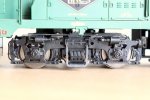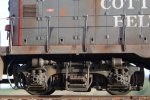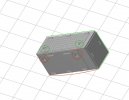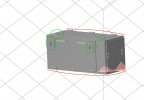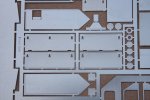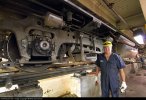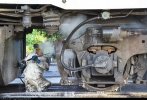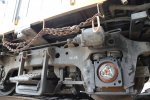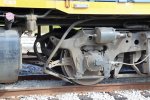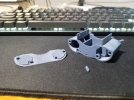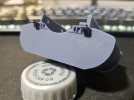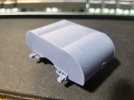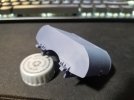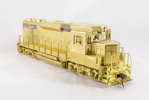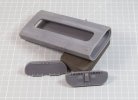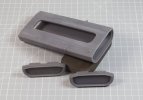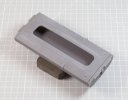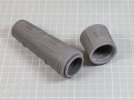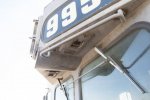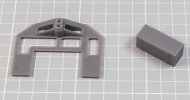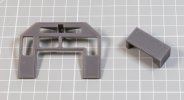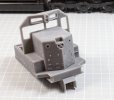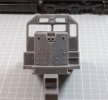Moving on to the anon, 3D printing and modelling.
I do a lot of it, sometimes it works well, really really well, other times it's a bag of

My biggest problem is that the really well stuff is not my main interest, actually my biggest problem is utter frustration and head banging fests.
To move forward may require a few big steps back if I'm honest, such as 'what the hell are you actually trying to achieve'. I know exactly what I want but am grinding toward the conclusion it isn't achievable, not with the equipment/skill set I current have, so where do you go from there. Anyway, that's a bag of snakes I'll have to deal with later or at some point.
Before I get there some history on where I'm trying to go, there's three possible routes;
1: upgrade RTR.
2: Buy expensive brass.
3: scratch build.
Option one I'm slowly doing with odd models here and there, MTH GEVO, Atlas SD35 plus a huge/growing stash ready for the butchers table.
Option 2 I do as and when I can, ironically it's not the expense that's holding me back, it's the accessibility of the models I really want and even then, expensive as brass is and all the kudos it gets, some models are really not that good under the skin.
Option 3 I've tried, etched Spartan cab and GEVO cabs, they're a step up from most aspects but still insanely hard work and still flawed, I'm not happy with either project to be honest, the 1st Gen EMD cab didn't fair well either, having said that, the MP15DC cab was much better and warrants a further test etch to hopefully bring it to fruition. Even then, the MP15DC is not a totally scratch build, it's an upgrade to a RTR model.
Etches work well for big flat slab sides and surfaces, just doing the spartan nose in etch was hateful, it's square and neat but making all the corner radius uniform and correct was just not good enough.
Enter 3D prints, on and off I've been dabbling with a RTR replacement spartan nose for my Atlas Southern Pacific SD35, in my case 2nd Gen 81". This last week it finally hit the home run and works, prints and fits the RTR chassis perfectly.
View attachment 154301
The light grey is from Atlas, medium grey from the hobby printer, dark grey from the Form. The cab front isn't the ideal one I want, although it does fit the SD35 in that they were fitted with extended windows, it's not the L screen that so typifies SP engines back then. I do have a L screen sitting in the queue waiting to be printed.
The sub base doors are not quite right but then there are many other little errors elsewhere (like the massive coupler box that'll need loads of work to put right) so does it really matter, hence my initial repose, 'what the hell are you actually trying to achieve'.
I can keep the bulk of the Atlas cab and just graft on the new front and walk away, in reality that's what I'll probably do with the shell and be done, the rest is another saga for a later day.
Buoyed by that small success I decided to try something more adventurous. I've not cleaned it up as there are bits still with errors in and some own goals, like forgetting to turn on the tread plate layer when exporting the chassis, pah
 View attachment 154302
View attachment 154303
View attachment 154304
View attachment 154305
View attachment 154302
View attachment 154303
View attachment 154304
View attachment 154305
This is where 3D prints are really

making one to fit a known location is hard work, but possible, making six all work and fit together is a hate fest, each part is just ever so slightly out it makes joining them all up with out gaps a nightmare.
The cab floor was an own goal, it clearly all fits in CAD but the swelling, flexing of the print in the machine of co-joining parts means it doesn't bloody well fit, not a little, a lot, so it needs re doing and compensating to get a better fit.
The same goes for the sub base cabinets, even with sacrificial edges to help joints there's still a small flex or bow in the base, about 0.3 mm between ends and centre, you can sand if flat but the bow works it's way up the side until it eventually fades out. That means that the lower rib on the longer door is also bowed slightly, thus even when you sand the base flat, that detail remains bowed.
The cab front....with signature SP L screen needs a different orientation to move the sacrificial edge away from the window frames, near impossible as they're an opening so at some point, an edge some where is going to be a sacrificial edge, that's the nature of SLA printing, the art is to minimise it as best you can, which on that point I might have an idea brewing.
The chassis, or that which is part of the body shell is ironically near perfect, except some berk forgot to turn on the tread plate layer when exporting, quite an expensive error given it's mass and time loss to print it (15 hours).
All in all, not the utopia I was hoping for and it'll take a lot of further testing, tweaking, printing to progress further/better, to the point where one has to ask is it worth it and yet once again, 'what the hell are you trying to achieve'. More importantly, this might not be the best way to do it.
Given the benefits/failures twixt etch and print, each has it's place, mixing them in this instance may also not be the right way forward either, what I can say though is that printing is a significantly faster process, etching can take days/weeks to draw up and then up to six weeks for delivery, then goodness knows how long to build.
I need more beer


 My biggest problem is that the really well stuff is not my main interest, actually my biggest problem is utter frustration and head banging fests.
My biggest problem is that the really well stuff is not my main interest, actually my biggest problem is utter frustration and head banging fests.

 . This is on my Dash 8.
. This is on my Dash 8.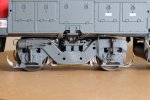
 - they'll almost disappear.
- they'll almost disappear. 